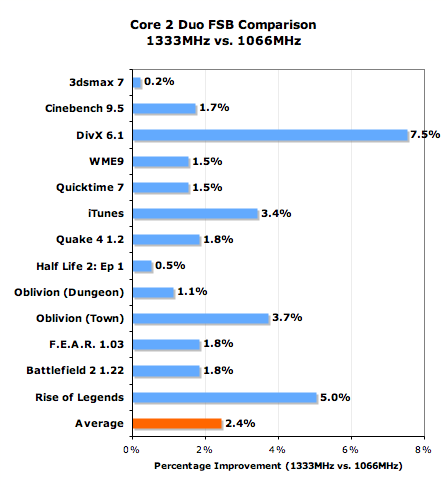Intel's Core 2 Extreme & Core 2 Duo: The Empire Strikes Back
by Anand Lal Shimpi on July 14, 2006 12:00 AM EST- Posted in
- CPUs
FSB Bottlenecks: Is 1333MHz Necessary?
Although all desktop Core 2 processors currently feature a 1066MHz FSB, Intel's first Woodcrest processors (the server version of Conroe) offer 1333MHz FSB support. Intel doesn't currently have a desktop chipset with support for the 1333MHz FSB, but the question we wanted answered was whether or not the faster FSB made a difference.
We took our unlocked Core 2 Extreme X6800 and ran it at 2.66GHz using two different settings: 266MHz x 10 and 333MHz x 8; the former corresponds to a 1066MHz FSB and is the same setting that the E6700 runs at, while the latter uses a 1333MHz FSB. The 1333MHz setting used a slightly faster memory bus (DDR2-811 vs. DDR2-800) but given that the processor is not memory bandwidth limited even at DDR2-667 the difference between memory speeds is negligible.
With Intel pulling in the embargo date of all Core 2 benchmarks we had to cut our investigation a bit short, so we're not able to bring you the full suite of benchmarks here to investigate the impact of FSB frequency. That being said, we chose those that would be most representative of the rest.
Why does this 1333MHz vs. 1066MHz debate even matter? For starters, Core 2 Extreme owners will have the option of choosing since they can always just drop their multiplier and run at a higher FSB without overclocking their CPUs (if they so desire). There's also rumor that Apple's first Core 2 based desktops may end up using Woodcrest and not Conroe, which would mean that the 1333MHz FSB would see the light of day on some desktops sooner rather than later.
The final reason this comparison matters is because in reality, Intel's Core architecture is more data hungry than any previous Intel desktop architecture and thus should, in theory, be dependent on a nice and fast FSB. At the same time, thanks to a well engineered shared L2 cache, FSB traffic has been reduced on Core 2 processors. So which wins the battle: the data hungry 4-issue core or the efficient shared L2 cache? Let's find out.

On average at 2.66GHz, the 1333MHz FSB increases performance by 2.4%, but some applications can see an even larger increase in performance. Under DivX, the performance boost was almost as high as going from a 2MB L2 to a 4MB L2. Also remember that as clock speed goes up, the dependence on a faster FSB will also go up.
Thanks to the shared L2 cache, core to core traffic is no longer benefitted by a faster FSB so the improvements we're seeing here are simply due to how data hungry the new architecture is. With its wider front end and more aggressive pre-fetchers, it's no surprise that the Core 2 processors benefit from the 1333MHz FSB. The benefit will increase even more as the first quad core desktop CPUs are introduced. The only question that remains is how long before we see CPUs and motherboards with official 1333MHz FSB support?
If Apple does indeed use a 1333MHz Woodcrest for its new line of Intel based Macs, running Windows it may be the first time that an Apple system will be faster out of the box than an equivalently configured, non-overclocked PC. There's an interesting marketing angle.










202 Comments
View All Comments
defter - Friday, July 14, 2006 - link
Xbitlabs has a great E6300 review:http://www.xbitlabs.com/articles/cpu/display/core2...">http://www.xbitlabs.com/articles/cpu/display/core2...
Overclocking was limited by a motherboard, but they still managed to achieve 2.94GHz with 420MHz FSB, not bad from a <$200 chip. E6300@2.94GHz was way faster than Athlon64X2@3GHz.
Frackal - Friday, July 14, 2006 - link
4ghz Conroe, holy shiatAndrewChang - Friday, July 14, 2006 - link
Loved the title, and loved the article. Can't wait till the Return of the Jedi...JackPack - Friday, July 14, 2006 - link
Jedi is considered to be weakest film of the three....formulav8 - Friday, July 14, 2006 - link
Yeah, but the Emperor WAS overthrown. :)Anyways, good job on the review. Intel is definitely trying to almost GIVE those PD cpu's away it seems. $93? Not that I don't blame them. They would almost HAVE to give them away to get rid of them.
Jason
haugland - Friday, July 14, 2006 - link
Page 18:According to the prices on page 2, the price for the 2.4GHz E6600 is $316, while the 2.13Ghz E6400 costs $224.
mobutu - Friday, July 14, 2006 - link
I quote:"The 2.4GHz E6600, which outperformed the FX-62 in most benchmarks at stock speed costs $223, and overclocked to 4Ghz with excellent air cooling"
It costs $316 according to Intel charts. Please fix it.
10x
JarredWalton - Friday, July 14, 2006 - link
Fixed (also for post below).mi1stormilst - Friday, July 14, 2006 - link
I was like skimming throught the article and thinking to myself wow. Then I went back and looked at the benchmarks and realized that until I see benchmarks with a wider range of video card and cpus I will reserve my excitement. At the moment my $120.00 used 3200 venice running at 2600MHZ with an X1800XL gives me some very good performance.JarredWalton - Friday, July 14, 2006 - link
I http://www.anandtech.com/guides/showdoc.aspx?i=279...">looked at performance with several CPUs using a 7600 GT (slower than X1800XL, but not by a huge amount). Basically, on lower end GPUs you will be GPU limited and just about any fast CPU. Maybe not always with NetBurst, but K8 and Core2 will be more than sufficient for all but multi-GPU setups (until next gen GPUs arrive).